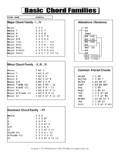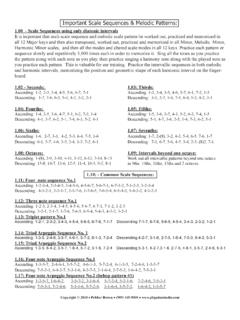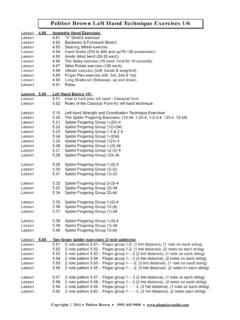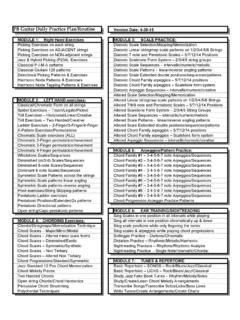Transcription of th - PB Guitar Studio
1 - 1 - The development of the Electric jazz Guitar in the 20th century by Pebber Brown One of the areas that is historically very important but sorely missing from any music texts, is that of the history of the jazz Guitar and its players. In this essay, I will explore some of its early origins as an instrument and briefly look at some of the significant early Guitar players of the 18th and 19th century who had an impact on later developments in jazz Guitar . Moving into the early part of the 20th century, I will also explore some of the influential non-classical guitarists who influenced the acceptance of the Guitar as a viable jazz instrument, and lastly I will explore the importance of the invention of the electric Guitar an look at some of the less well known but very important jazz guitarists of the 20th century.
2 Some insight into the origins of the Guitar The Guitar was invented many centuries ago in Spain as a predecessor of older Middle-Eastern stringed instruments such as the Zither, and the Lyre. The first guitars had less strings on them and were called "Chitarra." These instruments were played up until the 17th century when the more modern "Guitarra" was invented in Spain. The Guitarra later became the " Guitar ," and it made its way to Northern Europe and in England and the Netherlands they created their own version of it called the Lute. Lutes are most called "Baroque" lutes pertaining to the music played on them during the Baroque period. The word "guitarra" and "chitarra" are thought to have been originally been derived from the word "kithara," which is the name of an ancient Greek stringed instrument.
3 A member of the lute family, the Guitar has been known to have existed in Renaissance Europe. Many stringed instruments with similar names already existed over 400 years earlier, and - 2 - there exist some references in medieval French literature to the "gitere." In 14th century English literature an instrument called the gitarer is mentioned. Early instruments that resemble (or are similar in concept to) the Guitar may have existed in ancient Mesopotamia, Anatolia and Egypt and also in Central Asia at the beginning of the Christian era. According to , "As early as the 1600s, Spanish settlers had brought to the New World a European style Guitar with five sets of double strings.
4 By 1800 the six string instrument known today had evolved in southern Europe and was brought over from places like Italy and France. The instrument was popular enough by 1816 that the first instruction book was published. Most of these guitars were smaller than modern models and were strung with gut strings and plucked with the fingers. Though they were seldom known in the mountains or with the white working class of the South, a study of ex-slave narratives reveals a number of memories of Guitar -playing by blacks in pre-Civil War times, almost all of them located in the Mississippi River delta. There is little documentation as to how these guitars were played, but the location is significant: it would later be the center for the creation of classic delta blues and the birthplace of jazz .
5 If American vernacular music has an archetypal instrument it is certainly the Guitar . Though figures like Benjamin Franklin played a Guitar -like instrument, and genteel ladies like Andrew Jackson's wife Rachel played a gut-stringed "parlor Guitar ," the instrument didn't really achieve widespread use in the country until the twentieth century." ( ) - 3 - Some of early non-traditional Guitar players in the 18th and 19th century The 18th century (1700s) witnessed an overwhelming (too many to list) amount of important classical and flamenco Guitar players, however in traditional terms it really did not produce any famous or important non-classical ( jazz or blues) Guitar players, as the non-classical Guitar was mostly seen as a "parlor instrument" and was only played by amateur hobbyists and the curious.
6 In the American south the steel string Guitar managed to become a semi-popular instrument with slaves and they strummed folk and blues songs on them alongside the banjo players of the day. Many guitars were also brought over by immigrants from Europe during the peak immigration time period of 1776-1850. This was also documented as the main time period when America was flourishing and received the most amount of European immigrants it its history. According to Wikipedia, "The banjo is a stringed instrument developed by enslaved Africans in the United States, adapted from several African instruments.[1] The name banjo commonly is thought to be derived from the Kimbundu term mbanza. Some etymologists derive it from a dialectal pronunciation of "bandore", though recent research suggests that it may come from a Senegambian term for the bamboo stick used for the instrument's neck.
7 " ( ) The Banjo was popular with black slaves because it actually originated in Africa and it was brought over by the slaves early on and has since been updated and modified from its original animal skin construction method. Banjo players intermingled with players of the Guitar and in early jazz and blues recordings you can hear both being played simultaneously as rhythm instruments. - 4 - The 19th century (1800's) produced a remarkable black man who was a Guitar player named Justin Holland (1819-1886). Holland was a black musical composer and arranger and excellent performer on the Guitar , flute and piano.. Holland entered Oberlin College in 1841 and went on to become a music teacher in Cleveland, Ohio in 1845.
8 Holland was the first African-American to make an important contribution to the Guitar . "Holland's Method," was published in 1876, and it still to this day stands as one of the finest examples of Guitar instruction to appear in America from the 19th century. There are many published Guitar music pieces either written or arranged by Holland. The success and acceptance of Justin Holland intrigued many young African-American men who had an interest in becoming musicians but what was most important was that he single-handedly brought validation of the Guitar to the public. Holland inspired countless men of all races to take up the Guitar , and by the turn of the century, Sears Roebuck and company had guitars listed in their huge mail order catalog which found its way in to most homes in North America, resulting in many guitars being purchased and played by amateurs and hobbyists and the curios.
9 In Europe however, the Guitar remained as a proper classical instrument and was not regarded as something to take up as a hobby, but had a much more serious traditional classical and flamenco history to its development and did not become a popular household instrument like it did in America. - 5 - Some important non-traditional Guitar players in the early 20th century: As the Guitar became more popular to have around the house for many families during the 1800s, many people started playing the instrument and early folk singers emerged out of rural areas in places in North America including the South and Appalachia, giving birth to a long and rich heritage of American folk music.
10 As the Guitar became more widespread in North America, many people had access to one including many poor blacks and former slaves. By the turn of the century, Guitar manufacturers like the Martin Company (founded 1833) and the Gibson Guitar Company (founded 1894) had studied and improved Guitar -making techniques which allowed the use of much louder steel strings instead of the traditional "gut" strings. Steel string guitars became the rage in America and these were about as loud as the piano. When steel string guitars were played with picks, this created a much louder and twangy sound and allowed the Guitar to keep up with the other instruments in a string band, small group or as a solo instrument in its own right.







